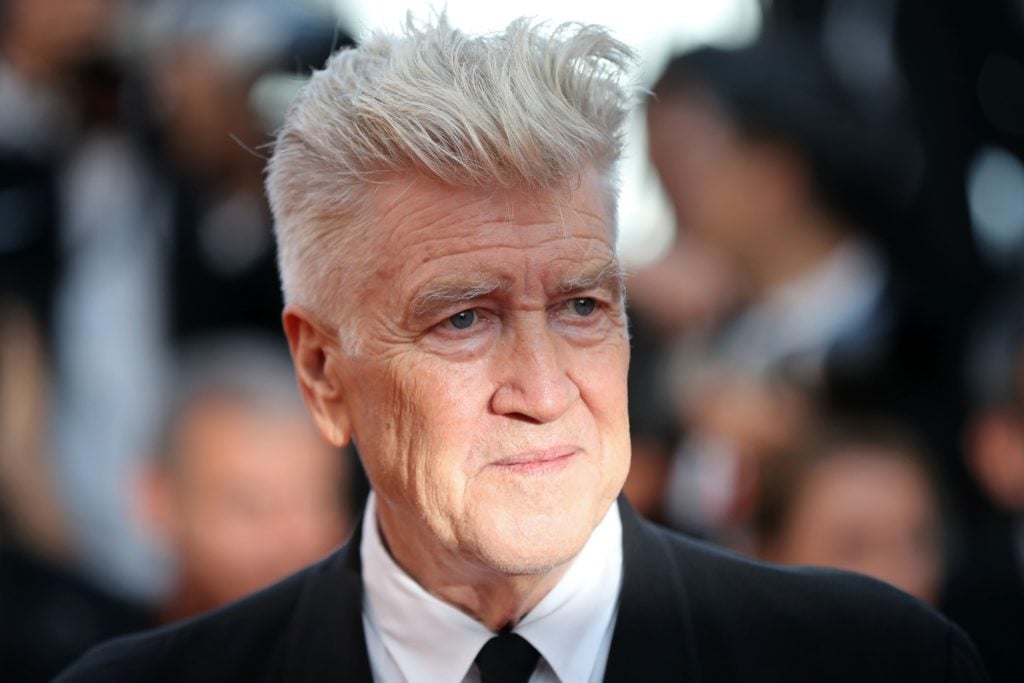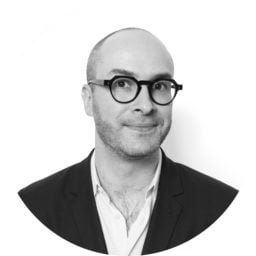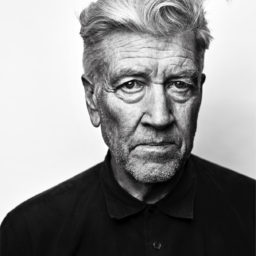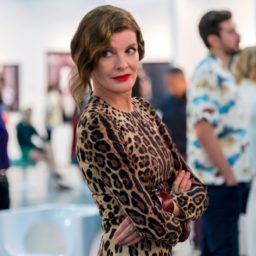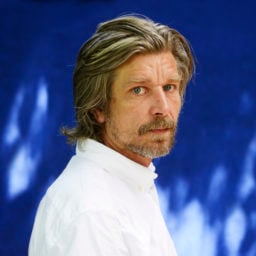There are some who see David Lynch’s transcendently spooky, mythopoetic work in film and television—and in particular his extraordinary-for-all-its-faults masterwork Twin Peaks—as among the greatest works of art of our time. Lynch, however, sees cinema as one arena and fine art as another—and he has every right to make the distinction, having been a painter, sculptor, and draughtsman as well as director all his adult life.
Born in Missoula, Montana, in 1946, Lynch caught the art bug early on through the influence of Bushnell Keeler, the artist father of a high-school friend. That propelled him to formally study painting first at the Corcoran School of Art, then at the Boston Museum School (now the School of the Museum of Fine Arts at Tufts), and later at the Pennsylvania Academy of the Fine Arts before a fateful day in the studio inspired him to concentrate on cinema.
While his work with film—and with transcendental meditation, which he has championed through his David Lynch Foundation since 2005—have gained far greater renown, his art has also met with success, with exhibitions in such venues as Leo Castelli Gallery, the Musée d’Orsay, La Triennale di Milano, and, just last year, shows of recent work at his gallery Kayne Griffin Corcoran in Los Angeles, where he lives.
Lynch is currently the subject of a massive survey show at the Bonnefantenmuseum in Maastricht, the Netherlands (through April 28), making it a prime destination for visitors already in the city for TEFAF this week.
To learn more about the show and about the artist and filmmaker’s distinctive view of art, artnet News’s Andrew Goldstein spoke to Lynch about his life’s other work.
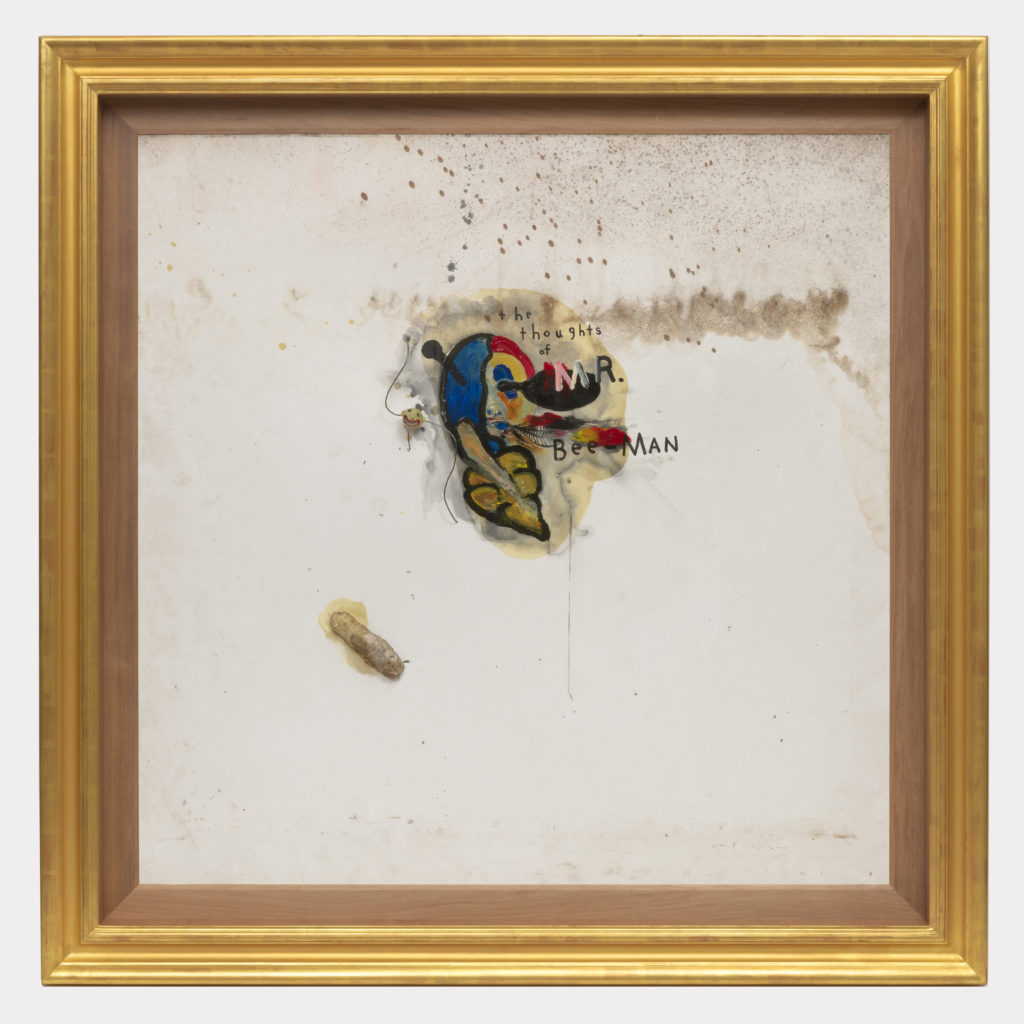
David Lynch’s The Thoughts of Mr. Bee-Man (2018). Image courtesy of the artist and Kayne Griffin Corcoran, Los Angeles. Photo: Robert Wedemeyer.
Congratulations on your show at the Bonnefantenmuseum in Maastricht. How did you come to have a survey of your art in the Netherlands?
Well, I don’t know how Stijn [Huijts, the Bonnefantenmuseum’s director] found out about my work, but he came to visit—I think it was through my art gallery here in LA—and he’s a really great guy. You know, I’ve been in the art world for a long time, and so I wanted to have a show, and here it is.
Was there a concept for the show?
No, no, no. It was to be a big show—that’s all, you know.
There is a fascinating section on the exhibition’s web page that says that when you were just starting out as an artist, you planned to study with the Austrian artist Oskar Kokoschka, but that fell though. How did you get in touch with Kokoschka?
I had painted all during high school—my friend Jack Fisk and I had four different studios during high school—and then I went to the Boston Museum School. I did not like it there, and so Jack and I decided we were going to go to Europe for three years to study with Kokoschka. And we came back in 15 days.
Why did you want to study with Kokoschka?
That’s a very good question. I have no earthly idea. We went off in a very unorganized way, and we got to Salzburg, where he apparently taught in this castle, and he wasn’t there and there wasn’t really any school set up—I guess he did more of a workshop. But Salzburg was way too clean and I really wanted to get out of there. So we spent most of the 15 days traveling on the Orient Express.
Kokoschka, of course, is famous for his intensive, haunting, highly stylized artworks. Looking back on the trajectory of your own artwork, you developed your own style very early on. Even during your youth in Pennsylvania, you honed in on a very atmospheric, mysterious way of painting, where there was always a sense of some threat lurking beneath the floorboards. Do you remember how this style came to you?
I say my biggest influence was the city of Philadelphia. It was an incredible city then. It was a city that was filled with fear, insanity, corruption, decay, violence, and a lot of disturbances in the air. But I loved the architecture and I loved the feel of a factory world, of smokestack industry and the buildings that went along with that. But I like the human form. I don’t know… I was saying recently, I’m still searching for a way to detect it. And I just keep painting to try to find it.
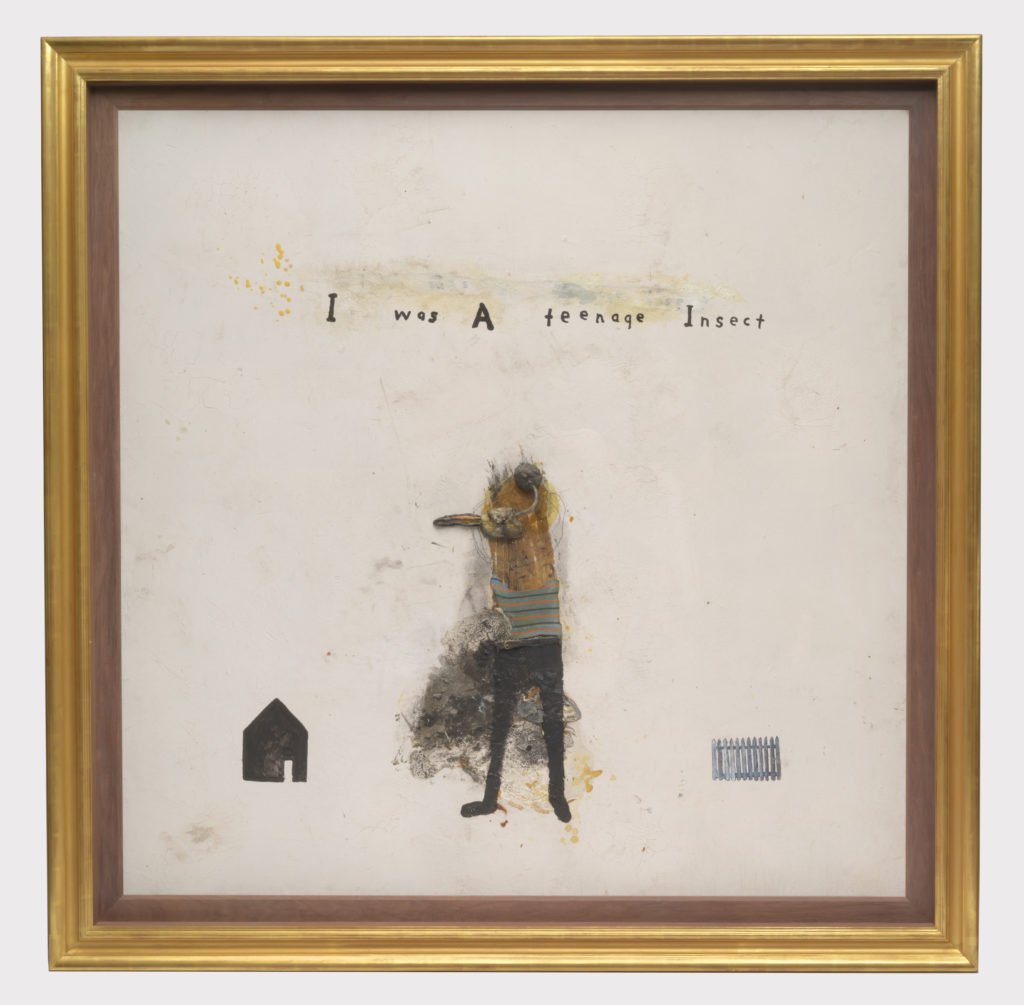
David Lynch’s I Was a Teenage Insect (2018). Image courtesy of the artist and Kayne Griffin Corcoran, Los Angeles. Photo: Robert Wedemeyer.
The years that you were in Philadelphia coincided with some of the darkest days of the ’60s. Was that part of your world while you were in art school? Was it something that you were paying attention to?
No, I wasn’t paying attention to it at all. Instead of thinking about a bigger picture and different things happening in the world, I’d prefer a smaller world—you know, just a few blocks big. I like close-ups more, and I feel that everything is there in the small world that’s in the big world. It’s just down to individuals and details and textures. I was interested in trying to get deep into that small world.
Since then, your films have become tremendously well known and, at the same time, you’ve continued to create your more intimately scaled artworks. Do you see these two channels, your film and your art, as somehow addressing the big world and the small world, as you put it?
No, I always say: Ideas drive the boat. Ideas for me are like gifts—precious things, blessings—and some ideas come for cinema and I fall in love with those ideas and that’s where I go. In the same way with painting, some idea comes and it drives me to paint. So it’s all about the ideas. I desire ideas, but I never know when they’re going to pop in. I also have a feeling that the more you do, the more the ideas will flow.
Do you find that when you’re working on films, you get ideas for artworks, and when you’re working on paintings, you get ideas for films?
Sometimes. The problem is that when you’re working on a film, it’s pretty much 24/7. So if a painting idea comes, I don’t have time to do the thing, and by the time the film is over, that idea has now moved on to other ideas. So those ideas that come during a film are ideas that were never painted, so it’s sad in a way. I get fired up sometimes but I don’t realize the idea because I can’t.
For years, one of the conversations around painting has been about justification. How do you justify making paintings—this ancient form of smearing colored dirt on cloth rectangles—when innovation has given us countless other ways to make new images? Often, cinema is brought up as the “superior” medium for modern times. You make extraordinary movies. Why do you still make paintings?
[Laughs] The thing is, it’s so beautiful. In a way, the image has gotten cheaper and cheaper and cheaper, and the world is filled with millions of images. But a painting is a unique thing. When you stand in front of a thing that’s not done on a computer, it’s a special thing. It’s like how a lithograph is way different than an image printed from a computer. So, those things, in my mind, are even more precious today than they used to be. You know, things go in waves, and I think that cinema will never die, painting will never die, lithography will never die, and still photography will never die either. The mediums are here to stay, and they’re infinitely deep. Ideas will come to take them further, but these different mediums are so fantastic. It sort of makes you crazy how how much there is to discover and do.
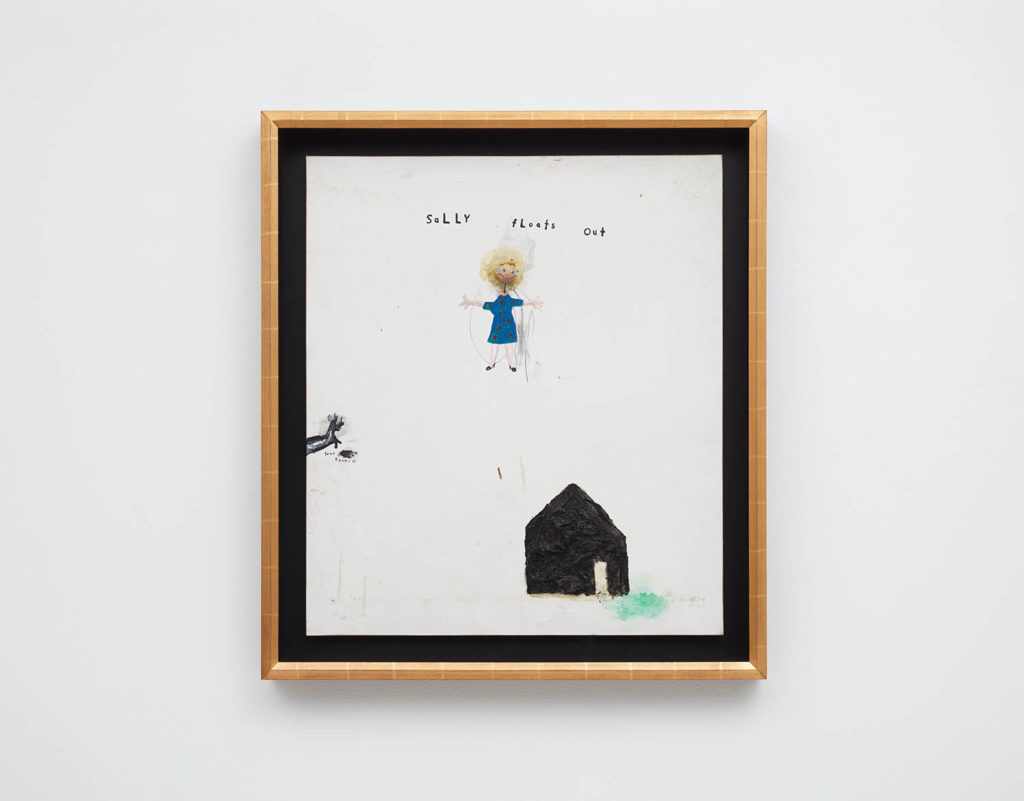
David Lynch’s Sally Floats Out (2018). Image courtesy of the artist and Kayne Griffin Corcoran, Los Angeles. Photo: Flying Studio.
When you talk about “the art life” in your book Catching the Big Fish, you treat it as an important vocation, something that demands single-minded focus. What role do you feel art plays in the world that makes it so important?
I always say you turn on the news and it has politics and it has weather and it has sports, but there’s no segment for painting. Once in a while they’ll talk about cinema, in terms of the box office or something having to do with money, but the percentage of the population that is in love with painting is very small. It’s such a personal, subjective world, and if you love it, that’s what you want to do. And it really doesn’t have anything to do with anything else that’s going on in the world.
You’ve made movies about filmmakers before, and cinema is a recurring element in your movies. Why have you never made a movie about a painter?
There have been movies made of painters, and it’s really pretty boring. It’s what happens in the interior of the painter and that’s interesting. It’s not something that is so exciting to observe. In a weird way, I don’t even care so much if people see my paintings, I just like to do it. I just love it, it’s a thing that I have loved since I was little.
Are there any movies about artists that you like?
No, not really. Well, I like Tim Roth in the film about Van Gogh [Vincent & Theo]. The story of Van Gogh is really great, the fact that he never sold anything and now his paintings are worth umpteen millions. I love his life, and his love of painting, and I love his painting. So that’s pretty interesting to me.
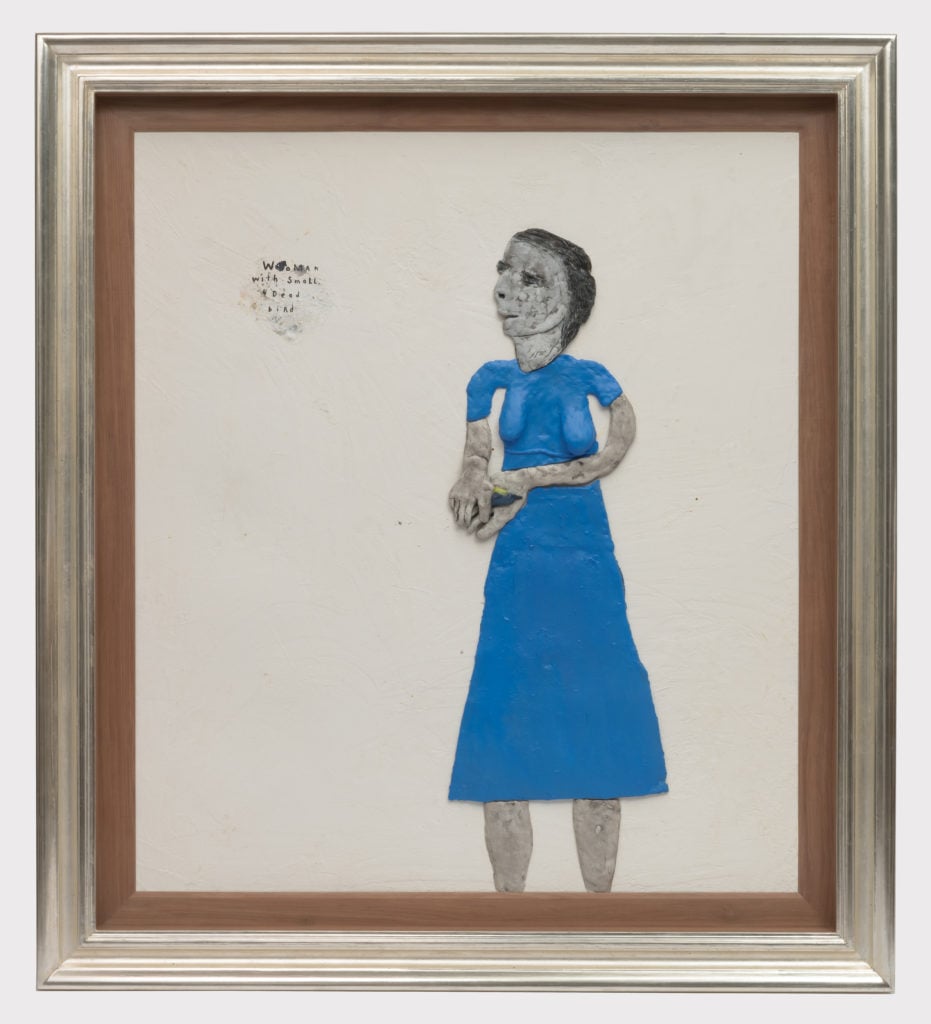
David Lynch’s Woman With Small Dead Bird (2018). Image courtesy of the artist and Kayne Griffin Corcoran, Los Angeles. Photo: Robert Wedemeyer.
How do you build painting into your day? Do you have a discipline?
I go where the ideas take me. Like, I’m working on a painting right now but I also am looking through boxes of written ideas and trying to organize those. So it depends on the day. My friend Bushnell Keeler, who was really responsible for me wanting to be a painter, said you need four hours of uninterrupted time to get one hour of good painting in, and that is really true. So I have a place to paint and I love being there, but I do get a lot of interruptions.
All these decades after you first took up painting, do you find yourself to be completely assured in the medium? Or are there still formal challenges that you struggle with?
But Andrew, that’s what it’s all about. I’ve never, never been successful. I’m looking for this thing, and that’s what drives you to do the next one and to discover something that just curls your hair.
For years, you’ve been making mixed-media sculptures that double as lamps. What is it about this form that fascinates you? Is there something appealing about making functional art, or does the interest come from somewhere else?
I don’t know when those things came about. I’m talking to you right now from my wood shop. I always love to build stuff, and so I have built tables and chairs and cabinets and different things, and then I started building lamps. These lamps are sculpture, and I love the fact that you can turn on a light in a piece of sculpture. I just I love the idea of electricity and light, and I love the shape and the texture of those little lightbulbs.

David Lynch’s Man With Potato (2015). Image courtesy of the artist and Kayne Griffin Corcoran, Los Angeles. Photo credit: Flying Studio.
Francis Bacon famously put his paintings behind glass to create something akin to a machine for viewing.
That’s the thing—that’s what got me going on those frames, seeing Francis Bacon’s work in 1966. I almost passed out it was so beautiful. That was at the Marlborough Gallery in New York City.
What drew you to his work so strongly?
Bacon is a guy who distorted figures, and how he painted them is unique and powerful, there’s no two ways about it. This guy knew what he was doing, and it flowed out of him. He is maybe my number-one favorite painter.
Who are some other artists you admire?
Edward Kienholz, and I really love [Julian] Schnabel’s paintings. For mood and painting quality, I like Edward Hopper. I like Lucian Freud. I like Calder, he’s a tip-top sculptor—I just love that guy.
Now, with your show in Maastricht, people have the chance to become influenced by your art. What are your hopes for your survey?
I always say that every single person is different on the surface, and when they stand in front of a painting, they are going to get something different from the next person who stands in front of the painting. So, you end up really painting for yourself, and you never know how things are gonna go over in film or in painting or anything.
“David Lynch: Someone Is in My House” is on view at the Bonnefantenmuseum, Avenue Ceramique 250, NL-6221 KX Maastricht, the Netherlands, November 20, 2018–April 28, 2019.
